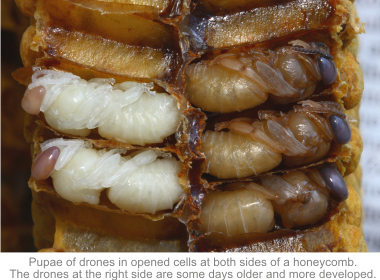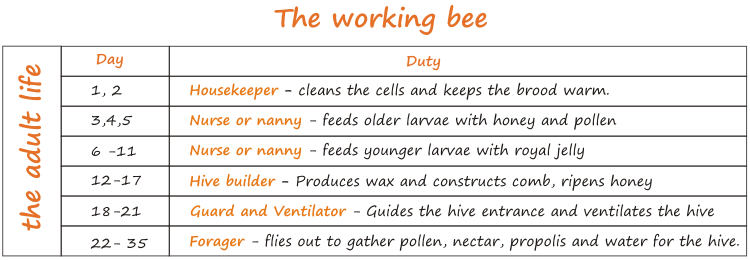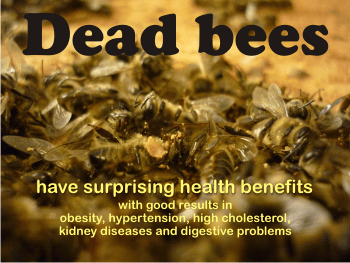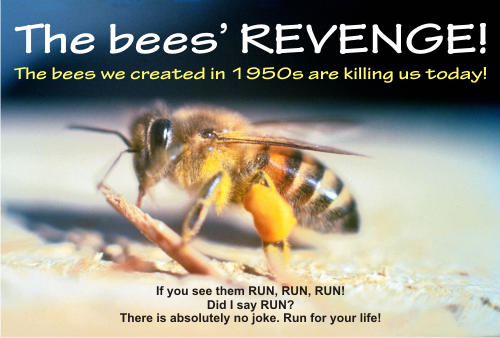To find out which are the jobs of a bee, we should first understand what is the life of a bee. It sounds rather strange to talk about “jobs” when coming to an insect, but this is exactly what it is. A job, or better put “an extended job” because it identifies with the entire lifetime.
Honey bees belong to the order HYMENOPTERA (from Greek: υμην= a membrane; πτερον= wing). In this order there are also wasps, saw-flies etc. Their characteristic is having four membranous wings with few veins, the hind part smallest. And, they suffer a complete transformation from the larva stage to the adult stage. If we look at the larva and at the adult, there is absolutely not resemblance!
THE BROOD STAGE
The brood stage means the stage before becoming an adult insect. Childhood, if you like, though it is not the same, because humans are physically the same in both stages, while these insects are completely different.
The queen is the one that gives life. After her (I’m going to tell it “her”, she’s unique and royalty!) nuptial flight, which means mating with 1 to more than 40 drones (yet, the average number of drones with which a queen mates is 12), the queen stores the sperm inside her body for the rest of her life. From that moment she will begin laying like 2000 eggs every day. The most heroic mother of all species!
The egg:
The queen lays a single egg in a cell, but before this, the cell must be spotless otherwise the queen will move to a different one. The worker bees are designed to clean them.
Cells are different. There are a wider drone-size cells, in which she will release a non fertilized egg which will develop into a drone (the male bee), smaller, standard worker-size cells where she releases a fertilized eggs for future worker bees (the female bees). In the hive, there are 5 worker bee cells per inch, and 4 drone cells per inch.
The laid egg will be attached to the cell bottom by a mucus strand, it will look like a tiny grain of rice and it will measure 1 to 1.5 mm long. When first laid, the egg stands straight up on end, but it will bend over during the first 3 days. On the third day, with a few hours before hatching, the nurse bees deposit royal jelly around the egg, which will soften chorion and facilitate hatching. The eggs will brake easily and the larvae will come out, looking like small white worms, 1.6 mm long, ventral curved, weighing 0.1 mg.

The larva:
A healthy larva is curled in a C shape and has a glistening pearly white color. In this stage, the larvae have a big appetite and they eat a lot. They are fed inside of their cells, by nurses bees, which are young adult workers bees, capable to produce a lot of jelly. They pour royal jelly on them, and the larvae begin swimming in circles with theirs mouths opened. Royal jelly consumption is achieved through the mouth and discontinuity between the mid gut and the posterior one makes it possible not to eliminate feces, at this stage. No matter if the bees will be drones, queens or workers, in the first three days of life, the larvae are fed with royal jelly.
Throughout the larval stage, a larvae is visited by a nurse about 10,000 times!
Most often in the 5th day, twice per minute!
Due to this food, the development of larvae is exceptional. Although they receive royal jelly only for the first three days after hatching, their weight goes from 0.1 mg to 142 mg, meaning that in such a short period of time, it increases 1400-1500 times for a worker bee, 2700 times for a queen and 3300 times for a drone larvae.
After the first 3 days, the drones and workers will be fed with a mixture of honey, pollen, and water, which is predigested, thus also enriched with enzymes, referred to as bee bread. (With the exception of the larva who is going to be a queen. If there is a need for a new queen, the worker will choose a regular worker larva and feed it only with royal jelly. Following the human saying “you are what you eat”, after eating only royal food, a queen will rise from a worker larva. No joke about that.)
Though the larva stage is considered to be from day 3 to 9, in the 6th day for the worker, 5 and a half for the queen and 6 and a half for the drone, the nurses will no longer feed the larvae and will cap the cells with a porous mixture of wax and pollen, that allows the passage of air. In this moment, the working larvae have an average weight of 140 mg, and the queens and drones have around 250 or 340 mg. Harvest and weather conditions can increase or decrease these numbers, so in poor food conditions, they may have only 60% of normal body weight.
Till day 9, this stage is called the pre-pupal stage. The larva is still grub-like in appearance but stretches itself out lengthwise in the cell and spins a thin silken cocoon. Larvae remain pearly white, plump and glistening during this pre-pupal stage.
The pupa
The pupae, also called nymphs, do not receive any kind of food from the nurse bees. At first they are white and shaped like adult bees, but without wings. Two days after the cells have been capped the transformation of larvae into pupae begins. It’s a slow, imperceptible transformation. From the 11th days a bee will have three body parts: head (with compound eyes, the first to take color, changing from white to brownish-purple), thorax and abdomen. Under the skin, soft buds will emerge into wings, legs and mouth parts.
From the pupa stage, adults will be born. Counting from the day the eggs were laid, a queen is born in the 16th day, a working bee in the 21st day and a drone in the 24th day.

THE ADULT STAGE
In the first day as an insect, the working bee has an incomplete physiological development. It needs to consume much pollen for next 6 to 8 days, for the skin to be fully pigmented, hypopharyngeal glands to develop, the sting to be operational etc. When growth is complete, it will not consume any more pollen, and the required nitrogen will be covered by the small amounts of protein and free amino acids present in honey.

Honey bees represent a highly organized society, with various bees having very specific roles during their lifetime: housekeeper, nanny, guards, grocers, housekeepers, construction workers, royal attendants, undertakers, foragers etc. From the day 1 of their existence as bees, these creatures identifies themselves with those jobs. Unlike humans, no special skills are required to qualify for the job of a nanny, a guard or a worker. The age is the only factor that counts.
Yet, they do go to a sort of school. When they are born they don’t know how to make honey so they are taught by the experienced ones. We should notice the great honey bee’s capability to learn and remember.
The working bees live for 6 weeks during the busy summer, and for 4-9 months during the winter months.
Do the honey bees ever sleep?
Some people say they don’t. But scientist say that they actually take very short naps, of only 1 minute, 250 times per day! Which is a little more than 4 hours.
Queens sleep for 8 hours per day. Probably that is why they live longer.

After getting out of the cells, the drones will still be fed by the bees, until the 4th day of their life as insects. Then they feed themselves with honey and bee bread in the comb. After the 8th day after hatching, between 11 o’clock and 17 o’clock, they get out of the mother hive to stretch their wings and fly. For fun. When they are 12th days old, they reach sexual maturity, being capable of mating. From this day on a drone will simply stay and wait for the mating flight with the queen. After mating, the drone dies, because he has a barbed sex organ which remains inside the queen and at leaving it tears off the drone’s abdomen.
Depending on the moment of mating, they can live between 32 to 58 days. If there is no mating flight and winter is coming, the drones will be expelled from the hive by the workers in autumn, as there is no use for them in the winter.
Immediately after hatching, the young queen looks for some honey in the uncapped cells, after which she will be fed on royal jelly only, by her own 5 or 6 attendants (young working bees). She is sexually immature in the first 3 or 4 days. From day 5 she can be fecundated by the drones (up to 40, but usually around 8 or 12). After a few days of rest, she will start laying eggs for the rest of her life. She will be productive for the first 2 years, but can live up to 5 years, and there have been reports of queen living even for 8 years.
Related articles:
• Honey bee QUEEN
• Can a honey bee see, smell, taste, touch, speak?
• Do honey bees communicate?
• Japanese Honeybees vs Giant Hornet
• How to treat bee sting
• How to treat bee sting allergy FOR GOOD!
Picture sources:
– “Bienenwabe mit Eiern und Brut 5” by Waugsberg Self-photographed. Licensed under CC BY-SA 3.0 via Wikimedia Commons;
– “Drohnenpuppen 79b” by Waugsberg – Own work. Licensed under CC BY-SA 3.0 via Wikimedia Commons;
– “Working honey bee cartoon” picture source http://www.search-best-cartoon.com/cartoon-honey-bee.html
References:
https://www.perfectbee.com/learn-about-bees/inside-and-out-of-the-beehive/
http://tolweb.org/treehouses/?treehouse_id=4864;
http://www.proapicultura.ro/stadii_de_dezvoltare.htm;
http://www.sciencedaily.com/releases/2007/10/071008183309.htm



